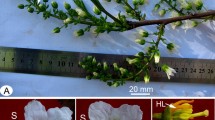Abstract
Inflorescence structure and floral morphology has been studied in 19 accessions of C. quinoa. All the accessions show gynomonoecy and bear three basic flower types viz. hermaphrodite, chlamydeous female and achlamydeous female and number of types can be extended to five considering the size of flowers. Ten types have been classified on the basis of the proportion of hermaphrodite and female flowers and their arrangement, depending upon the number of divisions of the dichasium on the glomerule. Implications of these results in facilitating intervarietal crosses are discussed.
Similar content being viewed by others
References
Bertin R.I. & Kerwin M.A. 1998. Floral sex ratios and gynomonoecy in Aster (Asteraceae). Amer. J. Bot. 85: 235–244.
Dostalek J. 1987. Influence of the mode of pollination on offsprings of some species of the genus Chenopodium. Preslia 59: 263–269.
Gandarillas H. 1969. Esterilidad genetica y citoplasmica de la quinua (Chenopodium quinoa). Turrialba 19: 429–430.
Gandarillas H. 1979. Botanica. Quinua y Kaniwa. Cultivos Andinos, pp. 20–44. In: Tapia M.E. (ed.), Serie Libros y Materiales Educativos. Instituto Interamericano de Ciencias Agricolas, Bogota, Columbia.
Jacobsen S.E., Mujica A. & Jensen C.R. 2003. The resistance of quinoa (Chenopodium quinoa Willd.) to adverse abiotic factors. Food Rev. Int. 19: 99–109.
Jensen C.R., Jacobsen S.E., Andersen M.N., Nunez N., Andersen S.D., Rasmussen L. & Mogensen V.O. 2000. Leaf gas exchange and water relation characteristics of field quinoa (Chenopodium quinoa Willd.) during soil drying. Eur. Jour. Agron. 13: 11–25.
Koziol M.J. 1992. Chemical composition and nutritional value of quinoa (Chenopodium quinoa Willd.). J. Food Comp. Anal. 5: 35–68.
Koziol M.J. 1993. Quinoa: A potential new oil crop, pp. 328–336. In: Janick J. & Simon J.E. (eds), New Crops, Wiley, New York.
Leon J. 1964. “Plantas Alimenticias,” Bol. Tec. No. 6. Instituto Interamericano de Ciencias Agricolas-Zona Andina, Lima, Peru.
Lescano R.J.L. 1980. Avances en la genetica de la quinua, pp. B1–B9. In: “Primera Reunion de Genetica y Fitomejoramiento de la Quinua”, Universidad Nacional Tecnica del Altiplano, Instituto Boliviano de Tecnologia Agropecuaria, Instituto Interamericano de Ciencias Agricolas, Centro Internacional de Investigaciones para el Desarrollo, Puno, Peru.
Mujica A., Jacobsen S.E., Ezquierdo J. & Marathee J.P. 2001. Resultados de la Prueba Americana y Europes de la Quinua, FAO, UNA-Puno, CIP, pp. 51.
Nelson D.C. 1968. Taxonomy and origins of Chenopodium quinoa and Chenopodium nuttalliae. Ph.D. Thesis, University of Indiana, Bloomington.
Ogungbenle H.N. 2003. Nutritional evaluation and functional properties of quinoa (Chenopodium quinoa) flour. Int. J. Food Sci. Nutr. 54: 153–158.
Oshodi A.A., Ogungbenle H.N. & Oladimeji M.O. 1999. Chemical composition, nutritionally valuable minerals and functional properties of benniseed (Sesamum radiatum), pearl millet (Pennisetum typhoides) and quinoa (Chenopodium quinoa) flours. Int. J. Food Sci. Nutr. 50: 325–331.
Partap T. & Upadhaya M.D. 1987. The Himalayan grain chenopods: Variations and their role in seed formation. Agri. Ecosys. & Environ. 18: 205–210.
Rea J. 1969. Biologia floral de la quinua (Chenopodium quinoa). Turrialba 19: 91–96.
Risi J. & Galwey N.W. 1984. The Chenopodium Grains of the Andes: Inca Crops for Modern Agriculture. Adv. Appl. Biol. 10: 145–216.
Simmonds N.W. 1971. The breeding system of Chenopodium quinoa. I. Male Sterility. Heredity 27: 73–82.
Tapia M. 1982. The environment, crops and agricultural systems in the Andes and Southern Peru. IICA.
Author information
Authors and Affiliations
Corresponding author
Rights and permissions
About this article
Cite this article
Bhargava, A., Shukla, S. & Ohri, D. Gynomonoecy in Chenopodium quinoa (Chenopodiaceae): variation in inflorescence and floral types in some accessions. Biologia 62, 19–23 (2007). https://doi.org/10.2478/s11756-007-0001-z
Received:
Accepted:
Published:
Issue Date:
DOI: https://doi.org/10.2478/s11756-007-0001-z




